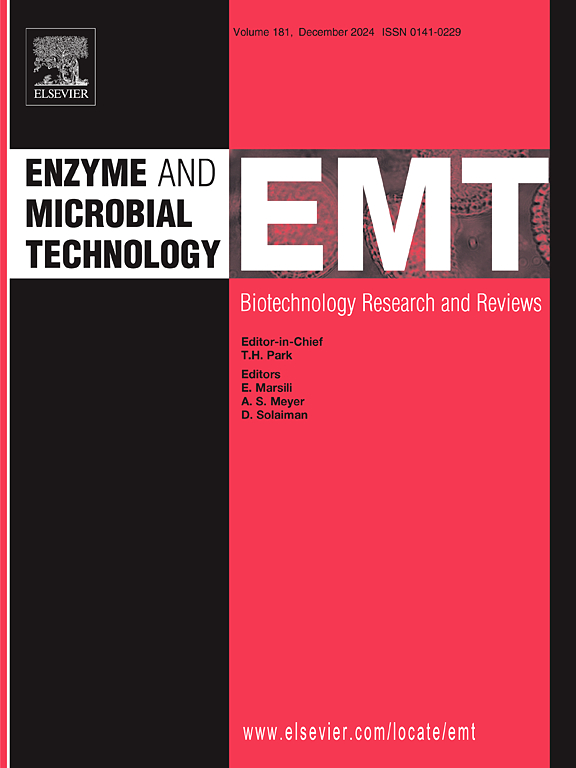GH67和GH115 α-1,2-葡萄糖醛酸酶与亚绿青霉内生聚糖酶的协同作用促进低聚木糖的产生
IF 3.7
3区 生物学
Q2 BIOTECHNOLOGY & APPLIED MICROBIOLOGY
引用次数: 0
摘要
植物细胞壁半纤维素多糖木聚糖的主要替代品是(4- o -甲基-)d-葡萄糖醛酸,它阻碍了内生木聚糖酶(XLNs)降解木聚糖以产生有价值的低聚木糖(XOS)。在这种情况下,α-1,2-葡萄糖醛酸酶(AGU)在水解4- o -甲基-d-葡萄糖醛酸和木聚糖中木基残基之间的α-(1→2)-糖苷键中起关键作用,从而促进XLNs产生XOS。然而,agu的研究相对较少,关于其生化特性、底物特异性和产品分析的数据不足和不完整限制了其应用。在此,我们克隆、异源制备、纯化了来自黑曲霉(Aspergillus niger)的AGU (AnAguA)和来自亚青霉(Penicillium subbrubescens)的AGU (PsAguB),并对其进行了功能鉴定,这两个AGU分别属于糖酶数据库中的糖苷水解酶家族67 (GH67)和115 (GH115)。结果表明,两种AGU均未释放聚合物山毛榉木葡萄糖醛酸(BeWX)中的4- o -甲基-d-葡萄糖醛酸。然而,我们发现从BeWX中预消化来自P. subbrubescens的GH10或GH11 XLNs(分别为PsXlnA和PsXlnF), AnAguA仅从葡氧醛酸低聚糖的非还原端释放4- o -甲基-d-葡萄糖醛酸,而PsAguB则从葡氧醛酸低聚糖的非还原端释放4- o -甲基-d-葡萄糖醛酸,而与木基取代位置无关。此外,我们还证明了在不同组合中添加agu对亚藜草GH10 (PsXlnA-C)和GH11 (PsXlnD-F, PsXlnH-I) xlu对XOS释放的促进作用因AGU-XLN组合的不同而不同。AnAguA与PsXlnA联合使用是最有效的,与单独使用PsXlnA相比,XOS的释放量至少增加了3倍,聚合度为5-7。本文章由计算机程序翻译,如有差异,请以英文原文为准。
Synergy of GH67 and GH115 α-1,2-glucuronidases with Penicillium subrubescens endoxylanases to stimulate xylooligosaccharide production
A primary substitution of the plant cell wall hemicellulosic polysaccharide xylan is (4-O-methyl-)d-glucuronic acid, which hinders the endoxylanases (XLNs) degradation of xylan for the production of valuable xylooligosaccharides (XOS). In this context, α-1,2-glucuronidase (AGU) plays a critical role in hydrolyzing the α-(1→2)-glycosidic linkages between 4-O-methyl-d-glucuronic acid and xylosyl residues in xylan, thereby enhancing XOS production by XLNs. However, AGUs have been relatively poorly studied, and insufficient and incomplete data on their biochemical properties, substrate specificity, and product profiling has limited their application. Here, we cloned, heterologously produced, purified and functionally characterized an AGU from Aspergillus niger (AnAguA) and another AGU from Penicillium subrubescens (PsAguB), belonging to Glycoside Hydrolase family 67 (GH67) and 115 (GH115), respectively, in the Carbohydrate-Active enZyme database. Results showed that neither AGU released 4-O-methyl-d-glucuronic acid from polymeric beech wood glucuronoxylan (BeWX). However, we found that from BeWX pre-digested with GH10 or GH11 XLNs from P. subrubescens (PsXlnA and PsXlnF, respectively), AnAguA released 4-O-methyl-d-glucuronic acid only from the non-reducing end of glucuronoxylan oligosaccharide, whereas PsAguB released 4-O-methyl-d-glucuronic acid from glucuronoxylan oligosaccharides regardless of the xylosyl substitution position. Furthermore, we demonstrated that enhancement of XOS release by adding AGUs to various combinations of GH10 (PsXlnA–C) and GH11 (PsXlnD–F, PsXlnH–I) XLNs from P. subrubescens varied based on the AGU-XLN combination. The combination of AnAguA with PsXlnA was the most effective, achieving at least a 3-fold increase in the release of XOS with a degree of polymerization of 5–7 compared to using PsXlnA alone.
求助全文
通过发布文献求助,成功后即可免费获取论文全文。
去求助
来源期刊

Enzyme and Microbial Technology
生物-生物工程与应用微生物
CiteScore
7.60
自引率
5.90%
发文量
142
审稿时长
38 days
期刊介绍:
Enzyme and Microbial Technology is an international, peer-reviewed journal publishing original research and reviews, of biotechnological significance and novelty, on basic and applied aspects of the science and technology of processes involving the use of enzymes, micro-organisms, animal cells and plant cells.
We especially encourage submissions on:
Biocatalysis and the use of Directed Evolution in Synthetic Biology and Biotechnology
Biotechnological Production of New Bioactive Molecules, Biomaterials, Biopharmaceuticals, and Biofuels
New Imaging Techniques and Biosensors, especially as applicable to Healthcare and Systems Biology
New Biotechnological Approaches in Genomics, Proteomics and Metabolomics
Metabolic Engineering, Biomolecular Engineering and Nanobiotechnology
Manuscripts which report isolation, purification, immobilization or utilization of organisms or enzymes which are already well-described in the literature are not suitable for publication in EMT, unless their primary purpose is to report significant new findings or approaches which are of broad biotechnological importance. Similarly, manuscripts which report optimization studies on well-established processes are inappropriate. EMT does not accept papers dealing with mathematical modeling unless they report significant, new experimental data.
 求助内容:
求助内容: 应助结果提醒方式:
应助结果提醒方式:


